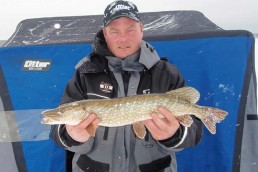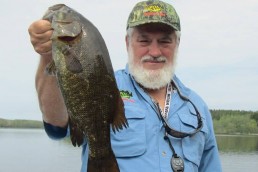Little Things Can Make a Big Difference for Smallmouths
SHARE THIS POST
April is a special month for many anglers throughout the Upper Midwest, since this windy month marks the beginning of river fishing season for smallmouth bass. Certainly the fish have been biting earlier, and by now many have been taken and released, but weather-wise, April is the month when the rivers have fallen to decent levels, the muddy water has cleared, temperatures have steadily risen and the fish are on the prowl.
Like most, I have been waiting, watching smallmouth fishing videos on my laptop, checking my boots for leaks and tinkering with my tackle. All the while I have been formulating a game plan in my mind of what has worked in the past and what little things I might want to change.
My goal for every year is not to drag along too much gear since river fishing is a highly mobile form of angling. One thing I try never to forget is a good wading staff. Most avant-garde sporting goods stores carry a full line of walking/hiking/skiing/fishing staffs that run the price gamut from fairly reasonable to fairly expensive. My favorite is a stout old broom handle with a hole bored through one end to accommodate a length of cord that I attach to my belt. I tie it so that the staff is right there at arm’s length in case I need it to prevent taking a tumble. I would not go into a river or a stream without a stick.
Almost any fishing rod/reel combo will work for taking smallies, but some are inherently better than others. My favorite outfit consists of a 6 1/2 spinning rod and a good open-face spinning reel.
I am a bit choosier when it comes to fishing line. Monofilament has been used by thousands of anglers for decades and still has many applications. However, I became tired of missing strikes and having my line popped by a fish so I have switched, almost exclusively, to braided line. With its no-stretch qualities, it offers a real advantage in both setting the hook and fighting a fish. For most applications 8-pound-test FireLine is hard to beat. Buy it in red or black and the fish will have a hard time detecting it in the water.
Are you enjoying this post?
You can be among the first to get the latest info on where to go, what to use and how to use it!
Since a smallmouth’s mood can change on a daily and sometimes hourly basis, I try to carry tackle to meet all situations. For crankbaits, medium-sized Rattlin’ Raps, Bass Pro Shops XTS Rattlin’ Shad, Berkley Frenzy Minnow in Bluegill or Crawdad colors, Rapala Original Floating Minnows in Blue/Silver or Black/Silver finishes and Rebel Wee Craws pretty well fill the bill. For topwaters, a small, black buzzbait, Rebel Pop-R’s in Natural and the great Rapala Original Floater twitched below a riffle all are bound to cause a big eruption on the surface and a good fight in the water.
Two old standards that usually are productive are the Mepp’s Spinner and the great Road Runner from TTI Blakemore. For the Mepp’s, try with both gold and silver blades in their Black, Orange or Chartreuse finishes. For the Road Runner, choose the Black body with a Pink, Chartreuse, Red or White tail and their Red hooks.
According to T. J. Stallings, director of marketing for TTI Blakemore, the Red hooks simulate the gill flash of a fleeing or wounded baitfish that triggers a strike from a predator such as a smallmouth.
There are more soft plastic lures from which to choose from than an angler can shake an ‘”Ugly Stik” at, but the field can be narrowed by recalling a few salient facts: A smallmouth lives and dies by the current, therefore it is constantly on the alert for anything that might swim, float or tumble by its nose. Choose soft plastic lures that resemble crawdads, minnows, hellgrammites, mice or insects and choose them in natural colors. Nearly 99 percent of the smallmouth’s day will be spent with the fish looking upstream in search of food, so make your casts accordingly. Bring the lure back toward yourself in a steady cadence, bounced or hopped across the bottom, free-floated, jigged, twitched, in a twitch-pause cadence or whatever suits the action of the lure or mood of the fish—experiment until the fish tell you what they want.
Stand with your feet positioned so that you can make a good hook-set and continue to retrieve the lure clear up to yourself and a little bit past your side. Smallies are notorious followers and they often strike just as the lure is being lifted from the water. These fish have been watching the lure in the water and the lifting action makes it look as though the intended prey is going to escape. A hungry fish cannot stand that and will hit it hard. Be ready, and believe that every cast could result in a good fish. Next to duck hunting, river fishing for smallies is my favorite outdoor activity, and I can hardly wait to begin.
MWO
SHARE THIS POST
Did you enjoy this post?
You can be among the first to get the latest info on where to go, what to use and how to use it!
John Bennett
John Bennett is a retired history teacher, historical re-enactor, father and grandfather. As a four-season outdoorsman, his passion is waterfowl hunting and fishing for smallmouth bass. He lives in Ohio and spends quite a bit of time in his primitive log cabin, which he built.



